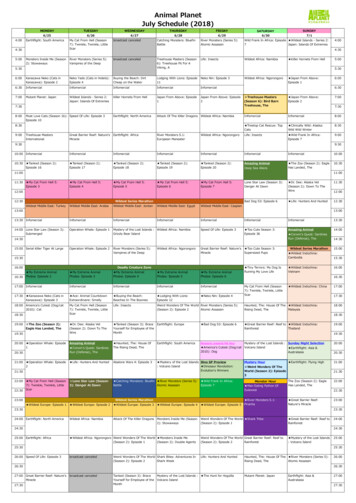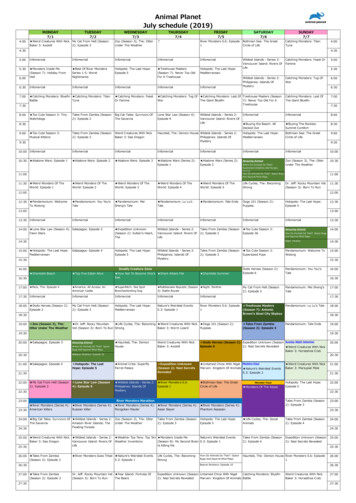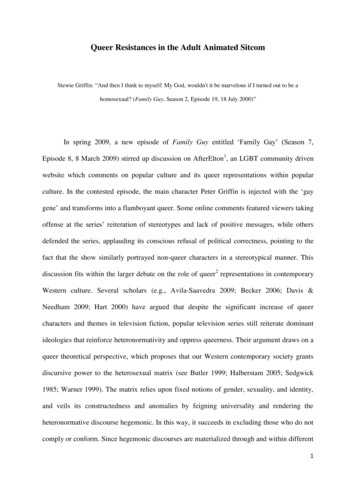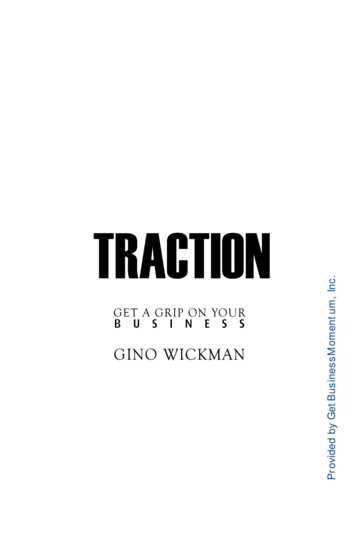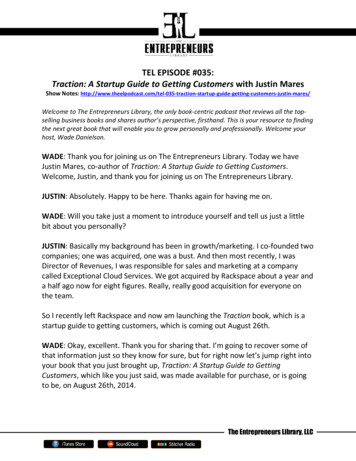
Transcription
TEL EPISODE #035:Traction: A Startup Guide to Getting Customers with Justin MaresShow Notes: up-guide-getting-customers-justin-mares/Welcome to The Entrepreneurs Library, the only book-centric podcast that reviews all the topselling business books and shares author’s perspective, firsthand. This is your resource to findingthe next great book that will enable you to grow personally and professionally. Welcome yourhost, Wade Danielson.WADE: Thank you for joining us on The Entrepreneurs Library. Today we haveJustin Mares, co-author of Traction: A Startup Guide to Getting Customers.Welcome, Justin, and thank you for joining us on The Entrepreneurs Library.JUSTIN: Absolutely. Happy to be here. Thanks again for having me on.WADE: Will you take just a moment to introduce yourself and tell us just a littlebit about you personally?JUSTIN: Basically my background has been in growth/marketing. I co-founded twocompanies; one was acquired, one was a bust. And then most recently, I wasDirector of Revenues, I was responsible for sales and marketing at a companycalled Exceptional Cloud Services. We got acquired by Rackspace about a year anda half ago now for eight figures. Really, really good acquisition for everyone onthe team.So I recently left Rackspace and now am launching the Traction book, which is astartup guide to getting customers, which is coming out August 26th.WADE: Okay, excellent. Thank you for sharing that. I’m going to recover some ofthat information just so they know for sure, but for right now let’s jump right intoyour book that you just brought up, Traction: A Startup Guide to GettingCustomers, which like you just said, was made available for purchase, or is goingto be, on August 26th, 2014.The Entrepreneurs Library, LLC
Justin, we’re going to move quickly, we’re going to move through a lot ofinformation, but we’re going to go through the top questions that ourlisteners/readers want to get answered about your guys’ book. What was theinspiration behind writing Traction?JUSTIN: Yeah, it was two things. My co-author, Gabriel Weinburg, he’s sold acompany in the past, he’s founder and CEO of DuckDuckGo, which is a privacybased search engine. As he got into angel investing and as I came in from thegrowth and starting companies side, we both noticed that today, when softwaretools are easily accessible, development and resources are abundant, thechallenge is not so much in building a product. You rarely see companies that arelike “Oh yeah, we failed because we couldn’t build a product.”The challenge now has shifted to companies are struggling to get traction. So theinspiration for writing the book was companies are failing because they can’t gettraction, not because they can’t build a product. Unlike when The Lean Startupcame out – I guess that was 5 years ago at this point, 4 or 5 years ago – a lot ofstartups were failing just because they were building products no one wanted,they were wasting development resources, and they just couldn’t build productsthat people wanted to engage with or whatever.Now, the biggest problem is that people are getting seed funding, building aproduct, getting some customers, but are failing to get enough traction to breakeven, to raise their next round, to do whatever they need to do. So that’s why wewrote the book, to provide startups with a framework and tools to focus on andget traction so that they can build successful companies.WADE: Okay, perfect. And what would you say makes your book different fromothers regarding the same topic?JUSTIN: A lot of things. If you look at the startup book ecosystem, things like TheLean Startup are “How do I interview my customers? How do I build a productthat has lean development cycles and we get a product out that certain peoplewant?” and all of that. That is all well and good and very effective; I’m very mucha proponent of the lean methodology.The Entrepreneurs Library, LLC
But what is different is that there’s no focus on how you actually bring a productto market. If you follow lean and customer development, you basically are talkingto customers, you’re getting in front of them, you’re building an MVP for yourfirst group of customers and all that, which is amazing – but there’s nothingcovered in terms of “Here’s how you grow to a level where you break even or to alevel where you can raise money from VCs or angel investors,” whatever it is.It’s in that gap that companies are failing now, and so our book, unlike any othersout there, provides something that we call the bull’s-eye framework, which is a 5step framework that helps companies determine what traction channels couldwork for them, so what marketing channels could potentially work for them toacquire customers. And then we introduce this framework and companies canactually use it to go through, figure out what channels make sense for them, andthen execute on those channels to reach their next phase of growth.WADE: Okay, excellent. How would you guys want the reader to engage with yourbook? Is this the kind of book they should start from the beginning, Page 1, andread all the way through? Or is this more of a resource where they can dive in,grab what they need, and dive back out?JUSTIN: It’s a mix. Essentially, the first couple chapters we introduce theframework, and then we have 19 chapters, one chapter for each traction channel.So a traction channel would be like PR, SEO, offline advertising, online advertising.What we basically did is provide the framework and the approach, like thestrategy section in the beginning of the book, and then we do a deep dive onevery potential channel that a startup could use to get traction in the remaining19 chapters of the book.WADE: Okay, excellent. Perfect. Justin, this is my favorite part of the entireinterview. This is the meat and potatoes, where we basically ask you to take usthrough your book. It doesn’t have to be chapter by chapter, but really give us anexcellent summary of what your book is all about.The Entrepreneurs Library, LLC
JUSTIN: Completely. Our book, the Traction book, we start with the first fivechapters. In these first five chapters, the first thing we introduce is that traction isnow the most important thing that startups need to focus on. Gone are the dayswhere a company struggled to raise money in the seed stage and had to spend 2billion buying servers to build their first generation of their product and all of thisstuff.So now what happens is seed funding is relatively abundant. If you have an ideaor just a very early product, you can raise seed money from any of the hundredsof accelerators that exist. Accelerators launch roughly 1,000 startups a year. Theonus of success has shifted from that to getting traction and actually getting yourproduct in front of people. So our first chapter talks about that.Then the next four chapters go through the bull’s-eye framework. What that is, isit’s a framework that helps founders, marketers, and entrepreneurs look at all ofthe 19 traction channels that are out there, figure out what channels make sensefor them – for example, if you need to go from 1,000 to 10,000 customers, you’reprobably looking at more scalable customer acquisition channels like SEO, paidacquisition, that type of stuff. If you’re trying to get your first 1,000 customers, achannel like SEO just doesn’t make sense.What we do is we provide this framework that helps you think through and figureout what channels are right for you, given your stage of growth, your funding,your resources on the team, show you how to run quick tests in each of thesechannels, and then how to evaluate which channel will make sense for you basedon the tests that you ran.Then the last thing, to wrap up our introductory couple chapters, is we cover howto run these tests, how to figure out whether a channel is right for you, like howmuch traction it’s provided, how much it costs, all of that. And then we also talkabout something that we call the traction split. This is the fact that early stagecompanies especially fall into this trap where they think “If we build a greatproduct, people are just going to flock to us.” And that’s not true. That’s just nottrue.The Entrepreneurs Library, LLC
What we talk about is early stage founders, early stage companies should bespending half of their time on product development and half on traction – whichyou see really successful companies do; you don’t see many companies do,though, period. Which is a shame.After we go through the strategy, how to think about frameworks, how to figureout what channels work for you, then we do deeper dives into the 19 tractionchannels.We go through viral marketing, which is acquiring users through virality – thinklike the Dropbox sharing program has worked really well for that. Public relations,so getting press to acquire customers. Unconventional PR, which we call –basically doing nice things for your users ala Zappos, or doing publicity stunts,things like Half.com bought a town and had it pre-named after their company.And then search engine marketing is another channel, so buying Adwords onGoogle, buying ads on Bing, Yahoo, and the like. Social and display advertising –those are the ads that you see all over the web, on Twitter, on Facebook,whatever it is. Offline ads, billboards and the like. Search engine optimization, sojust doing things to build links and make sure that your website shows up morehighly in search rankings or key terms. Content marketing – HubSpot, Unbounceare some great examples of companies that have used this channel well. Emailmarketing is another. Customer.io is doing incredible things with this; WP Engineas well.Engineering as marketing. This is one of my favorite channels personally, becauseit’s not one that you see a lot of companies use, but basically it’s using yourengineering resources to build a tool that brings you customers. A great exampleof this is HubSpot’s Marketing Grader, where you go to their Marketing Grader,you type in your site’s URL, and it automatically says “Here is what you could dobetter in SEO. Here’s what you could do better socially. Here’s what you could doin terms of blog optimization.” And this single tool, which they built in I want tosay 5 days or something, like 3 or 4 years ago, is responsible for 60% of theirinbound leads each month, and it drives like 40,000 to 50,000 leads a month.Which is insane.The Entrepreneurs Library, LLC
Other channels we cover are targeting blogs; guest posting is a common exampleof this. And then another channel is business development, so partnerships,licensing, stuff like that. Sales is another way that startups can get traction.Affiliate programs, like HostGator, one of the biggest hosting programs out there;Bluehost is another. Both have grown to tens of millions of dollars in revenue in avery short span of time by having incredible affiliate programs.Another channel that we cover is existing platforms. This is another interestingone where existing platforms are essentially places where users already exist thatyou hack or take advantage of to get users onto your platform. Think like Airbnb’sCraigslist hack; that was an example of them using Craigslist, which is an existingplatform of demand, existing platform of users. They hacked it to bring a lot ofusers onto Airbnb. Other examples are just like the iTunes App Store, the GooglePlay Store, all of the like.The remaining four channels that we cover in the book are tradeshows – verytried and true; offline events, so meet-ups, conferences, things like that; speakingengagements; and then community building. So there are companies that havegrown by building a community. Yelp has done this really well, Evite, Eventbrite,all of these companies have done a great job building a community and growingthrough that community.After covering all those channels, we just wrap with a conclusion that saysbasically “Here is how to think about it,” we provide more resources, andessentially give founders a cheat sheet for how they can think about, approach,and then get traction through whatever channel makes sense for them.WADE: Great. My first question based on what you were just talking about wouldbe, through these 19 channels, you basically cover every kind of business thatsomeone can own?And what I mean by that, for example, would be my wife and I currently own an ITproduct sales company, we own an IT services company, we have a podcast, andThe Entrepreneurs Library, LLC
then I have a friend who’s about to start his own donut, so a retail. So you’retalking about retail, services, product, and then entertainment on the podcastside – four what I would consider pretty different kinds of businesses. Is theresomething through those 19 channels for every single one of those?JUSTIN: Yeah, absolutely. What we tried to cover – I mean, honestly, the purposeof the book is we want this to be a must-read for startup founders so that nomatter what kind of company you’re starting, you pick this up, you’reautomatically ahead of most individuals that think about starting a companybecause you’re thinking about marketing and traction and the like, and then youcan find the type of business and the type of traction channel that works for whatyou’re doing.So for retail, you mentioned, things like offline ads, existing platforms, speakingengagements, and community building are very tried and tested to drive retaildemand. So even though they’re very different types of businesses, we reallytried to encompass and interview people and figure out what is every potentialway that a new company could get traction, and let’s cover that in the book.WADE: Wow. Yeah, I’m already looking at it, like I could use this book for so manydifferent things in my personal life. Do you know off the top of your head howmany of those different channels you guys are using to say promote this book?JUSTIN: Yeah, we are going to be testing nine of them. Because certain ones, likean offline ad, buying a radio ad or a billboard probably doesn’t make sense tomove this book. We may test it – depends how well the book does. I think it’ll doreally well. But if we’re suddenly just flowing in cash, we may test it. But as far asstarting up marketing, it doesn’t make sense to drop like 10 grand on a billboardand hope that it moves books, you know?WADE: Excellent, okay. This next question I believe is difficult, because you justwent through a ton of great content and context. So if the reader could only takeaway one concept, principle, or action item out of your entire book, what wouldyou want that to be?The Entrepreneurs Library, LLC
JUSTIN: This is something that we call the Law of Crappy Click-Throughs. This isessentially this law that if you look at any acquisition channel – think like paidacquisition, doing Adwords, whatever it is – as more and more people start to usethat platform to acquire customers, the effectiveness of that channel goes downand the cost for that channel goes up. So where you could buy Adwords clicks at 5cents or 3 cents 5 years ago, now you can probably not get a click for under 75cents.What this means is if you’re starting a company and don’t have a ton of budget,what you need to do is try and find a new platform or a new way to acquire usersthat is not already saturated and really expensive.WADE: Gotcha. Okay, very good.JUSTIN: Does that make sense?WADE: Yeah. Oh yeah, absolutely. Justin, this next question is more – I’m hopingthat it’s a way for you to kind of brag on yourself. And if you don’t have one, thenmaybe ones that your readers, that some people that maybe got a release, maybethey’ve gotten back to you on it. But do you have a favorite quote from yourbook?JUSTIN: Yeah, favorite quote. We actually have two. One that we incorporatedinto the book is from Marc Andreessen. He started Netscape, went public; he’sone of the most successful VCs in the Valley. His quote is like the #1 reason thatthey pass on entrepreneurs that they would otherwise like to back, is that theydon’t have a good distribution strategy.Which is crazy if you think about it, because anyone who’s writing about – most ofthe startup blog ecosystem right now talks about “the best product wins,” andwhat the best VC in the Valley is saying is that the #1 reason they pass onentrepreneurs is because they don’t think about distribution. So that’s one.The other is just what I said at the beginning, which is that most companies don’tfail to build a product; they fail to get traction.The Entrepreneurs Library, LLC
WADE: Excellent, those are fantastic ones. The last question that we have for youtoday is if there was only one book you could recommend to our listeners/readersbased on the way it’s impacted your life – we’re really trying to dig deep, a bookthat has created a paradigm shift for you and helped you either growprofessionally or personally – what book would you recommend?JUSTIN: The one book that made the biggest impact on me – it’s pretty commonand well-known, but The 4-Hour Workweek was actually the first time – not that Iwas like “Oh man, I want to live abroad and outsource my life” and all that, but itwas the first time that my eyes were opened to the fact that I didn’t have tograduate, get a normal job, and move up the corporate ladder. It was the firsttime that this alternate universe of entrepreneurship, starting companies, and allthis was really shown to me, and it’s completely changed my life.WADE: Awesome. Same for me. That book changed my life as well, so I love whenI hear that one come up. Justin, before we depart, can you recommend the bestway for our listeners to get more information on you, your co-author Gabriel, andyour book, Traction?JUSTIN: Yeah. Check out tractionbook.com. If you want, you can sign up to ouremail list there; we’ll send you the first chapter free. Otherwise, you can preorderit on Amazon. There’s links to it from tractionbook.com.As far as me personally, you can check out my blog, justinmares.com. And thenmy co-author, his blog is gabrielweinburg.com. He’s a relatively well-known techinvestor, writer, and all the above.WADE: All right, perfect. Justin, thank you so much for coming on today andsharing your book with us.JUSTIN: Awesome, thanks so much for having me.WADE: Absolutely. Thanks again for listening in today. If you would like to getyour hands on Traction or any of the other resources mentioned by Justin, justThe Entrepreneurs Library, LLC
look at the show notes at TheELPodcast.com. And if there is a book you wouldlove to hear reviewed by the author, please visit us on iTunes and leave us areview with the book title.Looking for your next book idea? Head over to TheELPodcast.com, where Wade shares hisamazing resource, “The Top 10 Business Books Recommended by Over 500 Entrepreneurs,” withyou for free. That’s TheELPodcast.com. Till the next time, keep it on the EL.LINKS AND RESOURCES MENTIONED IN THIS EPISODE:Check out The 4-Hour Workweek by Tim Ferriss on AmazonVisit TractionBook.com to learn more about Justin’s book and join his listVisit JustinMares.com to learn more about JustinVisit GabrielWeinburg.com to learn more about GabrielBuy Traction: A Startup Guide to Getting Customers by Justin Mares on AmazonThe Entrepreneurs Library, LLC
So a traction channel would be like PR, SEO, offline advertising, online advertising. What we basically did is provide the framework and the approach, like the strategy section in the beginning of the book, and then we do a deep dive on every potential channel that a startup could use to get traction i

